NSB104 Leading & Learning: Responding to Nursing Leadership Challenges
VerifiedAdded on 2023/06/12
|10
|2650
|72
Essay
AI Summary
This essay critically examines leadership challenges in nursing, drawing upon the short story "A Real Pain" by Paola Scamperle to highlight key issues such as commitment, communication, and collaboration within healthcare settings. It reflects on the author's personal development as a leader and learner, identifying preferred leadership styles and their potential impact on clinical practice. The essay proposes clear strategies, supported by evidence-based literature, to address these challenges, including fostering open communication, encouraging teamwork, and promoting influential leadership. The conclusion emphasizes the importance of these strategies in improving patient care and achieving better outcomes in nursing practice. Desklib offers a wealth of similar solved assignments and past papers to aid students in their studies.
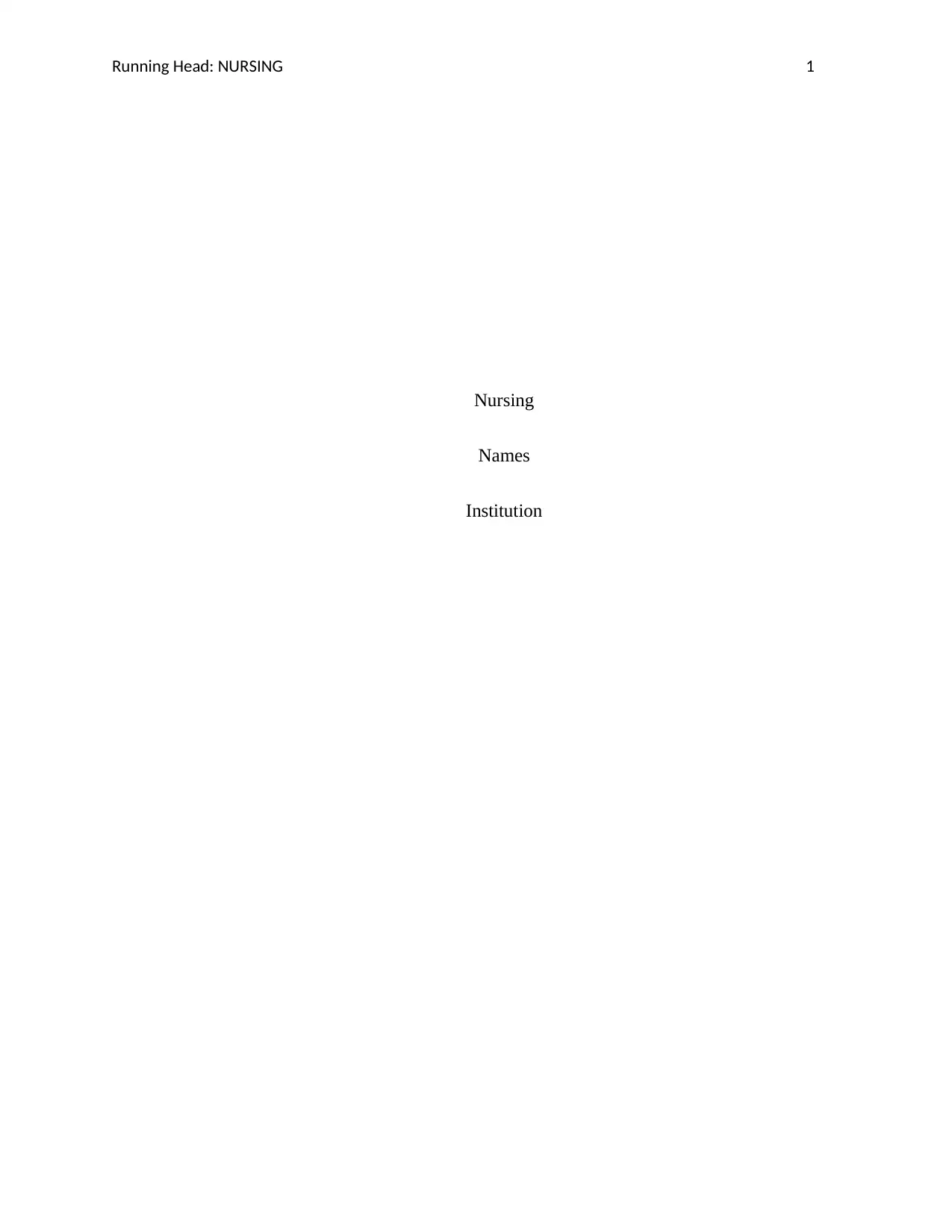
Running Head: NURSING 1
Nursing
Names
Institution
Nursing
Names
Institution
Paraphrase This Document
Need a fresh take? Get an instant paraphrase of this document with our AI Paraphraser
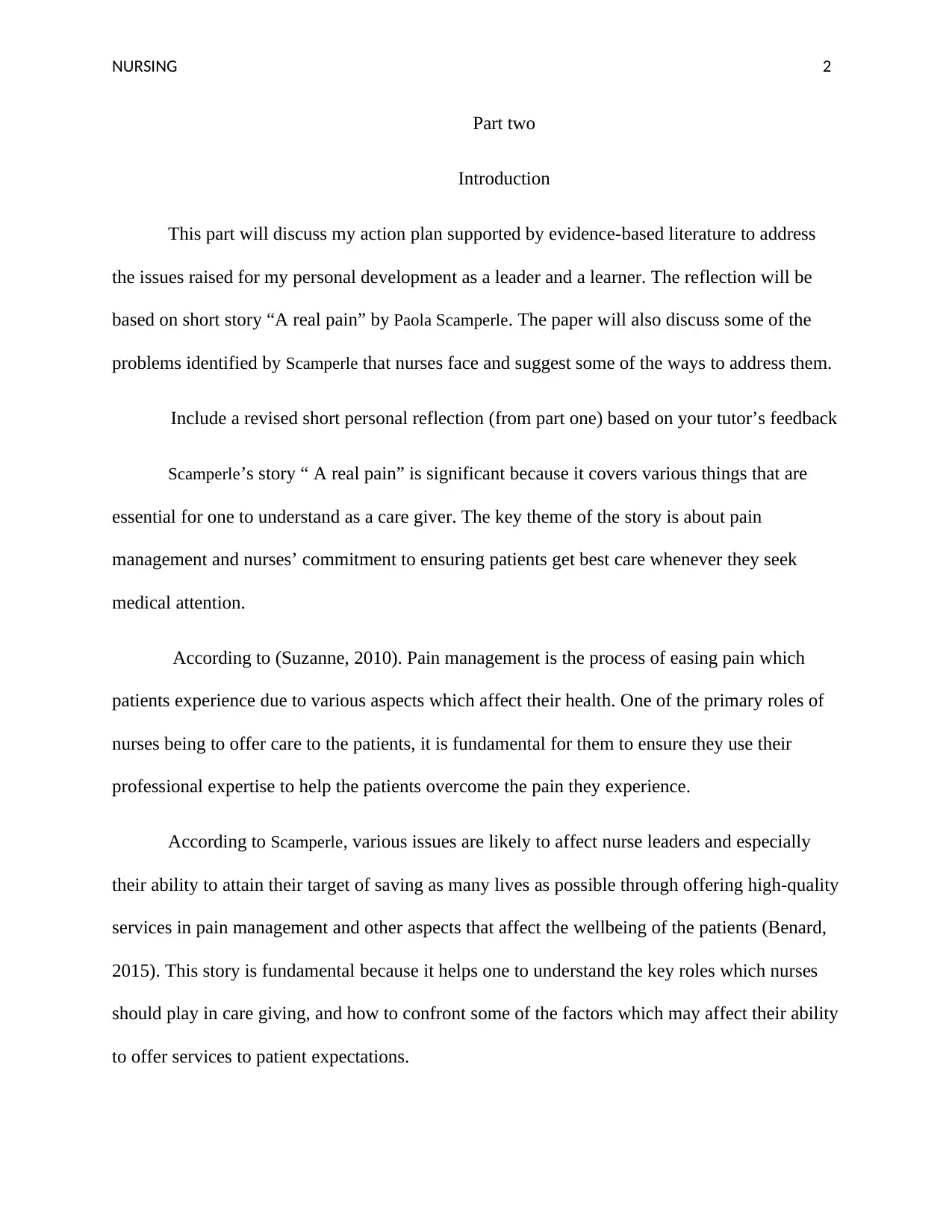
NURSING 2
Part two
Introduction
This part will discuss my action plan supported by evidence-based literature to address
the issues raised for my personal development as a leader and a learner. The reflection will be
based on short story “A real pain” by Paola Scamperle. The paper will also discuss some of the
problems identified by Scamperle that nurses face and suggest some of the ways to address them.
Include a revised short personal reflection (from part one) based on your tutor’s feedback
Scamperle’s story “ A real pain” is significant because it covers various things that are
essential for one to understand as a care giver. The key theme of the story is about pain
management and nurses’ commitment to ensuring patients get best care whenever they seek
medical attention.
According to (Suzanne, 2010). Pain management is the process of easing pain which
patients experience due to various aspects which affect their health. One of the primary roles of
nurses being to offer care to the patients, it is fundamental for them to ensure they use their
professional expertise to help the patients overcome the pain they experience.
According to Scamperle, various issues are likely to affect nurse leaders and especially
their ability to attain their target of saving as many lives as possible through offering high-quality
services in pain management and other aspects that affect the wellbeing of the patients (Benard,
2015). This story is fundamental because it helps one to understand the key roles which nurses
should play in care giving, and how to confront some of the factors which may affect their ability
to offer services to patient expectations.
Part two
Introduction
This part will discuss my action plan supported by evidence-based literature to address
the issues raised for my personal development as a leader and a learner. The reflection will be
based on short story “A real pain” by Paola Scamperle. The paper will also discuss some of the
problems identified by Scamperle that nurses face and suggest some of the ways to address them.
Include a revised short personal reflection (from part one) based on your tutor’s feedback
Scamperle’s story “ A real pain” is significant because it covers various things that are
essential for one to understand as a care giver. The key theme of the story is about pain
management and nurses’ commitment to ensuring patients get best care whenever they seek
medical attention.
According to (Suzanne, 2010). Pain management is the process of easing pain which
patients experience due to various aspects which affect their health. One of the primary roles of
nurses being to offer care to the patients, it is fundamental for them to ensure they use their
professional expertise to help the patients overcome the pain they experience.
According to Scamperle, various issues are likely to affect nurse leaders and especially
their ability to attain their target of saving as many lives as possible through offering high-quality
services in pain management and other aspects that affect the wellbeing of the patients (Benard,
2015). This story is fundamental because it helps one to understand the key roles which nurses
should play in care giving, and how to confront some of the factors which may affect their ability
to offer services to patient expectations.
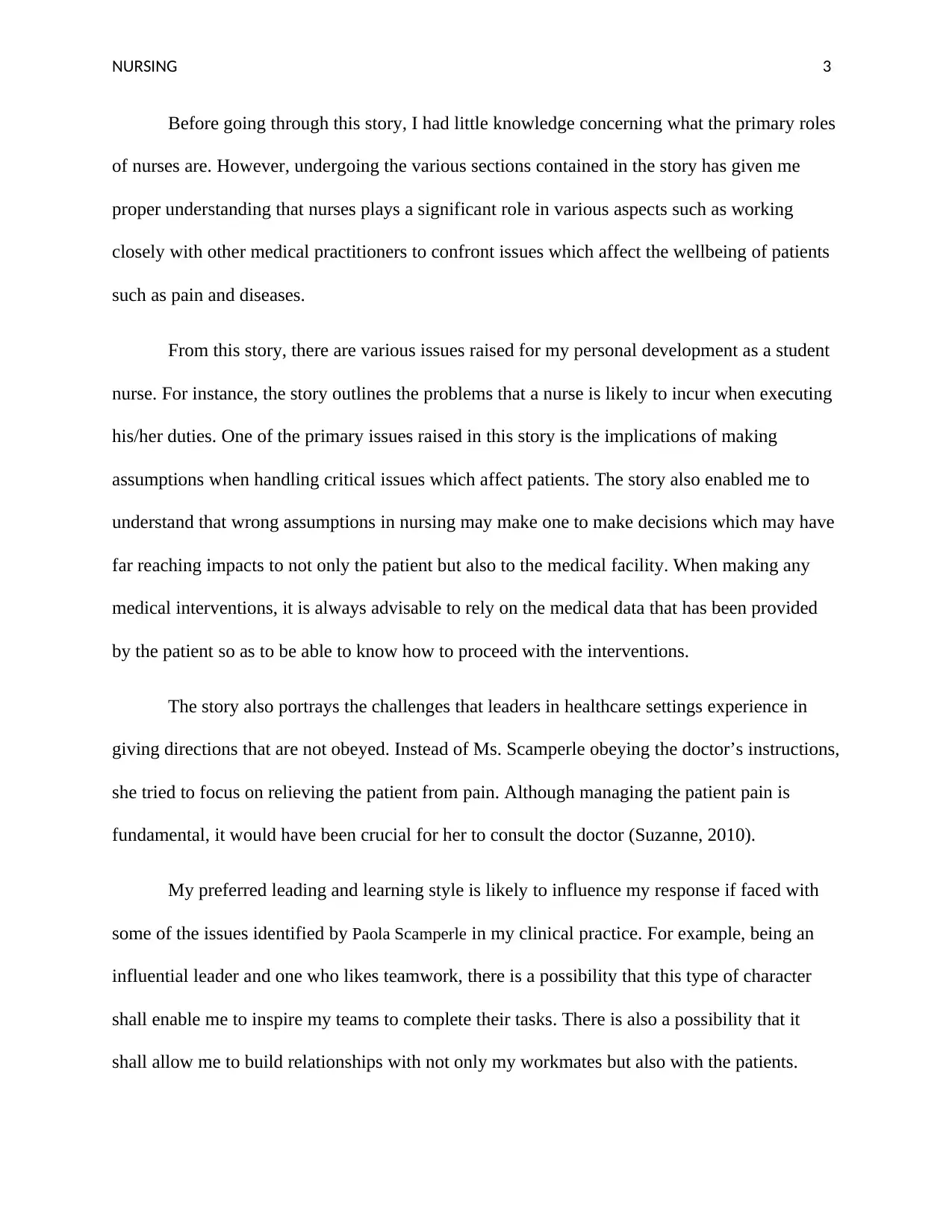
NURSING 3
Before going through this story, I had little knowledge concerning what the primary roles
of nurses are. However, undergoing the various sections contained in the story has given me
proper understanding that nurses plays a significant role in various aspects such as working
closely with other medical practitioners to confront issues which affect the wellbeing of patients
such as pain and diseases.
From this story, there are various issues raised for my personal development as a student
nurse. For instance, the story outlines the problems that a nurse is likely to incur when executing
his/her duties. One of the primary issues raised in this story is the implications of making
assumptions when handling critical issues which affect patients. The story also enabled me to
understand that wrong assumptions in nursing may make one to make decisions which may have
far reaching impacts to not only the patient but also to the medical facility. When making any
medical interventions, it is always advisable to rely on the medical data that has been provided
by the patient so as to be able to know how to proceed with the interventions.
The story also portrays the challenges that leaders in healthcare settings experience in
giving directions that are not obeyed. Instead of Ms. Scamperle obeying the doctor’s instructions,
she tried to focus on relieving the patient from pain. Although managing the patient pain is
fundamental, it would have been crucial for her to consult the doctor (Suzanne, 2010).
My preferred leading and learning style is likely to influence my response if faced with
some of the issues identified by Paola Scamperle in my clinical practice. For example, being an
influential leader and one who likes teamwork, there is a possibility that this type of character
shall enable me to inspire my teams to complete their tasks. There is also a possibility that it
shall allow me to build relationships with not only my workmates but also with the patients.
Before going through this story, I had little knowledge concerning what the primary roles
of nurses are. However, undergoing the various sections contained in the story has given me
proper understanding that nurses plays a significant role in various aspects such as working
closely with other medical practitioners to confront issues which affect the wellbeing of patients
such as pain and diseases.
From this story, there are various issues raised for my personal development as a student
nurse. For instance, the story outlines the problems that a nurse is likely to incur when executing
his/her duties. One of the primary issues raised in this story is the implications of making
assumptions when handling critical issues which affect patients. The story also enabled me to
understand that wrong assumptions in nursing may make one to make decisions which may have
far reaching impacts to not only the patient but also to the medical facility. When making any
medical interventions, it is always advisable to rely on the medical data that has been provided
by the patient so as to be able to know how to proceed with the interventions.
The story also portrays the challenges that leaders in healthcare settings experience in
giving directions that are not obeyed. Instead of Ms. Scamperle obeying the doctor’s instructions,
she tried to focus on relieving the patient from pain. Although managing the patient pain is
fundamental, it would have been crucial for her to consult the doctor (Suzanne, 2010).
My preferred leading and learning style is likely to influence my response if faced with
some of the issues identified by Paola Scamperle in my clinical practice. For example, being an
influential leader and one who likes teamwork, there is a possibility that this type of character
shall enable me to inspire my teams to complete their tasks. There is also a possibility that it
shall allow me to build relationships with not only my workmates but also with the patients.
⊘ This is a preview!⊘
Do you want full access?
Subscribe today to unlock all pages.

Trusted by 1+ million students worldwide
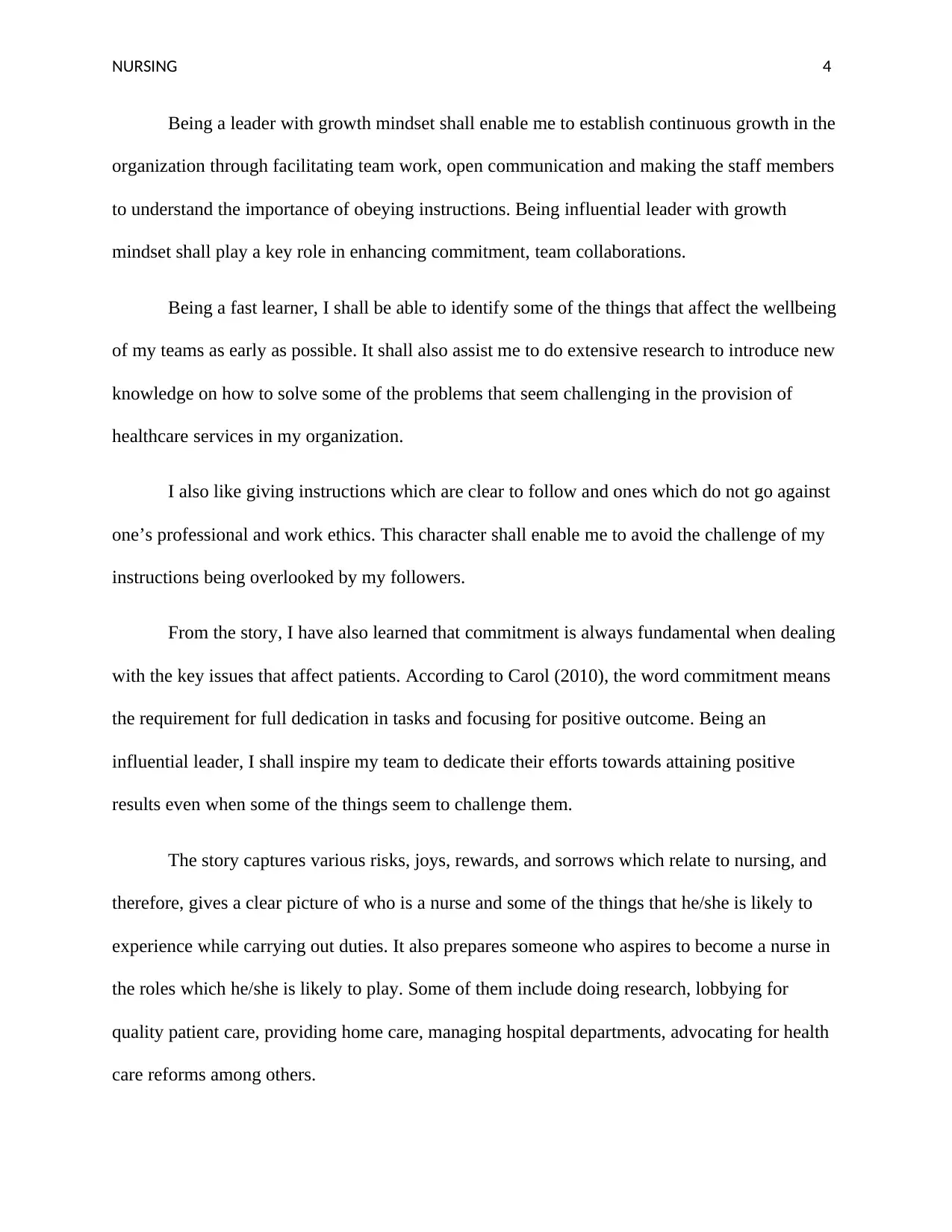
NURSING 4
Being a leader with growth mindset shall enable me to establish continuous growth in the
organization through facilitating team work, open communication and making the staff members
to understand the importance of obeying instructions. Being influential leader with growth
mindset shall play a key role in enhancing commitment, team collaborations.
Being a fast learner, I shall be able to identify some of the things that affect the wellbeing
of my teams as early as possible. It shall also assist me to do extensive research to introduce new
knowledge on how to solve some of the problems that seem challenging in the provision of
healthcare services in my organization.
I also like giving instructions which are clear to follow and ones which do not go against
one’s professional and work ethics. This character shall enable me to avoid the challenge of my
instructions being overlooked by my followers.
From the story, I have also learned that commitment is always fundamental when dealing
with the key issues that affect patients. According to Carol (2010), the word commitment means
the requirement for full dedication in tasks and focusing for positive outcome. Being an
influential leader, I shall inspire my team to dedicate their efforts towards attaining positive
results even when some of the things seem to challenge them.
The story captures various risks, joys, rewards, and sorrows which relate to nursing, and
therefore, gives a clear picture of who is a nurse and some of the things that he/she is likely to
experience while carrying out duties. It also prepares someone who aspires to become a nurse in
the roles which he/she is likely to play. Some of them include doing research, lobbying for
quality patient care, providing home care, managing hospital departments, advocating for health
care reforms among others.
Being a leader with growth mindset shall enable me to establish continuous growth in the
organization through facilitating team work, open communication and making the staff members
to understand the importance of obeying instructions. Being influential leader with growth
mindset shall play a key role in enhancing commitment, team collaborations.
Being a fast learner, I shall be able to identify some of the things that affect the wellbeing
of my teams as early as possible. It shall also assist me to do extensive research to introduce new
knowledge on how to solve some of the problems that seem challenging in the provision of
healthcare services in my organization.
I also like giving instructions which are clear to follow and ones which do not go against
one’s professional and work ethics. This character shall enable me to avoid the challenge of my
instructions being overlooked by my followers.
From the story, I have also learned that commitment is always fundamental when dealing
with the key issues that affect patients. According to Carol (2010), the word commitment means
the requirement for full dedication in tasks and focusing for positive outcome. Being an
influential leader, I shall inspire my team to dedicate their efforts towards attaining positive
results even when some of the things seem to challenge them.
The story captures various risks, joys, rewards, and sorrows which relate to nursing, and
therefore, gives a clear picture of who is a nurse and some of the things that he/she is likely to
experience while carrying out duties. It also prepares someone who aspires to become a nurse in
the roles which he/she is likely to play. Some of them include doing research, lobbying for
quality patient care, providing home care, managing hospital departments, advocating for health
care reforms among others.
Paraphrase This Document
Need a fresh take? Get an instant paraphrase of this document with our AI Paraphraser
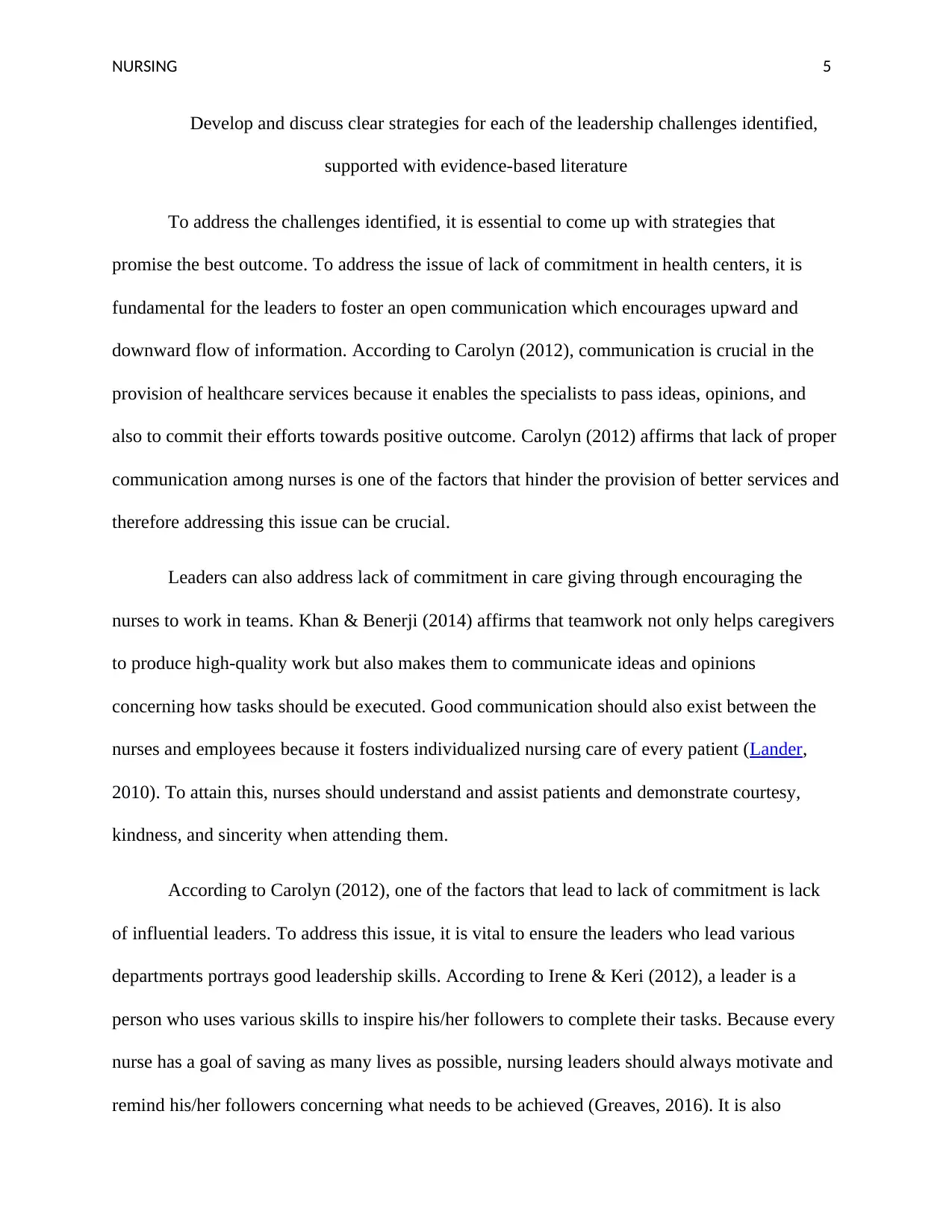
NURSING 5
Develop and discuss clear strategies for each of the leadership challenges identified,
supported with evidence-based literature
To address the challenges identified, it is essential to come up with strategies that
promise the best outcome. To address the issue of lack of commitment in health centers, it is
fundamental for the leaders to foster an open communication which encourages upward and
downward flow of information. According to Carolyn (2012), communication is crucial in the
provision of healthcare services because it enables the specialists to pass ideas, opinions, and
also to commit their efforts towards positive outcome. Carolyn (2012) affirms that lack of proper
communication among nurses is one of the factors that hinder the provision of better services and
therefore addressing this issue can be crucial.
Leaders can also address lack of commitment in care giving through encouraging the
nurses to work in teams. Khan & Benerji (2014) affirms that teamwork not only helps caregivers
to produce high-quality work but also makes them to communicate ideas and opinions
concerning how tasks should be executed. Good communication should also exist between the
nurses and employees because it fosters individualized nursing care of every patient (Lander,
2010). To attain this, nurses should understand and assist patients and demonstrate courtesy,
kindness, and sincerity when attending them.
According to Carolyn (2012), one of the factors that lead to lack of commitment is lack
of influential leaders. To address this issue, it is vital to ensure the leaders who lead various
departments portrays good leadership skills. According to Irene & Keri (2012), a leader is a
person who uses various skills to inspire his/her followers to complete their tasks. Because every
nurse has a goal of saving as many lives as possible, nursing leaders should always motivate and
remind his/her followers concerning what needs to be achieved (Greaves, 2016). It is also
Develop and discuss clear strategies for each of the leadership challenges identified,
supported with evidence-based literature
To address the challenges identified, it is essential to come up with strategies that
promise the best outcome. To address the issue of lack of commitment in health centers, it is
fundamental for the leaders to foster an open communication which encourages upward and
downward flow of information. According to Carolyn (2012), communication is crucial in the
provision of healthcare services because it enables the specialists to pass ideas, opinions, and
also to commit their efforts towards positive outcome. Carolyn (2012) affirms that lack of proper
communication among nurses is one of the factors that hinder the provision of better services and
therefore addressing this issue can be crucial.
Leaders can also address lack of commitment in care giving through encouraging the
nurses to work in teams. Khan & Benerji (2014) affirms that teamwork not only helps caregivers
to produce high-quality work but also makes them to communicate ideas and opinions
concerning how tasks should be executed. Good communication should also exist between the
nurses and employees because it fosters individualized nursing care of every patient (Lander,
2010). To attain this, nurses should understand and assist patients and demonstrate courtesy,
kindness, and sincerity when attending them.
According to Carolyn (2012), one of the factors that lead to lack of commitment is lack
of influential leaders. To address this issue, it is vital to ensure the leaders who lead various
departments portrays good leadership skills. According to Irene & Keri (2012), a leader is a
person who uses various skills to inspire his/her followers to complete their tasks. Because every
nurse has a goal of saving as many lives as possible, nursing leaders should always motivate and
remind his/her followers concerning what needs to be achieved (Greaves, 2016). It is also
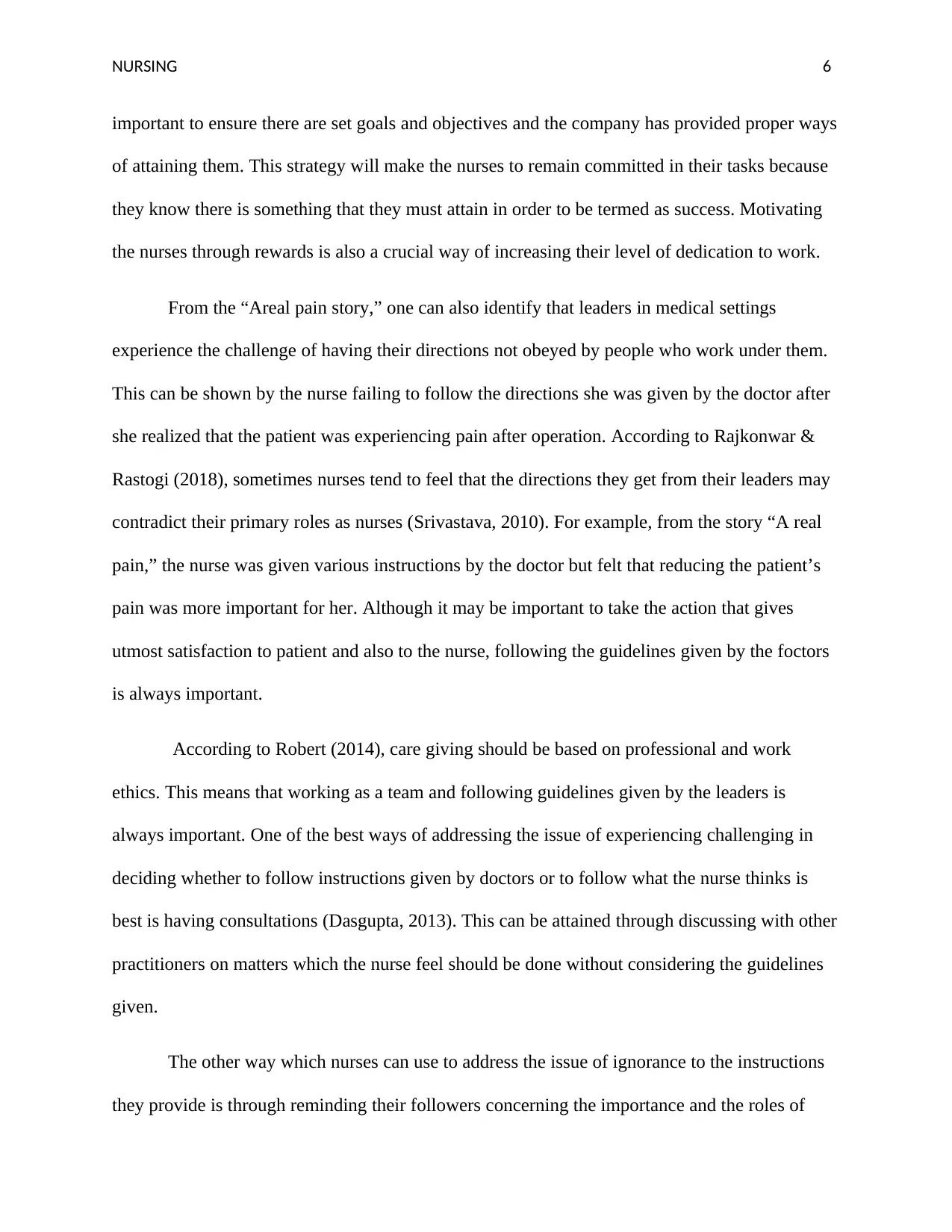
NURSING 6
important to ensure there are set goals and objectives and the company has provided proper ways
of attaining them. This strategy will make the nurses to remain committed in their tasks because
they know there is something that they must attain in order to be termed as success. Motivating
the nurses through rewards is also a crucial way of increasing their level of dedication to work.
From the “Areal pain story,” one can also identify that leaders in medical settings
experience the challenge of having their directions not obeyed by people who work under them.
This can be shown by the nurse failing to follow the directions she was given by the doctor after
she realized that the patient was experiencing pain after operation. According to Rajkonwar &
Rastogi (2018), sometimes nurses tend to feel that the directions they get from their leaders may
contradict their primary roles as nurses (Srivastava, 2010). For example, from the story “A real
pain,” the nurse was given various instructions by the doctor but felt that reducing the patient’s
pain was more important for her. Although it may be important to take the action that gives
utmost satisfaction to patient and also to the nurse, following the guidelines given by the foctors
is always important.
According to Robert (2014), care giving should be based on professional and work
ethics. This means that working as a team and following guidelines given by the leaders is
always important. One of the best ways of addressing the issue of experiencing challenging in
deciding whether to follow instructions given by doctors or to follow what the nurse thinks is
best is having consultations (Dasgupta, 2013). This can be attained through discussing with other
practitioners on matters which the nurse feel should be done without considering the guidelines
given.
The other way which nurses can use to address the issue of ignorance to the instructions
they provide is through reminding their followers concerning the importance and the roles of
important to ensure there are set goals and objectives and the company has provided proper ways
of attaining them. This strategy will make the nurses to remain committed in their tasks because
they know there is something that they must attain in order to be termed as success. Motivating
the nurses through rewards is also a crucial way of increasing their level of dedication to work.
From the “Areal pain story,” one can also identify that leaders in medical settings
experience the challenge of having their directions not obeyed by people who work under them.
This can be shown by the nurse failing to follow the directions she was given by the doctor after
she realized that the patient was experiencing pain after operation. According to Rajkonwar &
Rastogi (2018), sometimes nurses tend to feel that the directions they get from their leaders may
contradict their primary roles as nurses (Srivastava, 2010). For example, from the story “A real
pain,” the nurse was given various instructions by the doctor but felt that reducing the patient’s
pain was more important for her. Although it may be important to take the action that gives
utmost satisfaction to patient and also to the nurse, following the guidelines given by the foctors
is always important.
According to Robert (2014), care giving should be based on professional and work
ethics. This means that working as a team and following guidelines given by the leaders is
always important. One of the best ways of addressing the issue of experiencing challenging in
deciding whether to follow instructions given by doctors or to follow what the nurse thinks is
best is having consultations (Dasgupta, 2013). This can be attained through discussing with other
practitioners on matters which the nurse feel should be done without considering the guidelines
given.
The other way which nurses can use to address the issue of ignorance to the instructions
they provide is through reminding their followers concerning the importance and the roles of
⊘ This is a preview!⊘
Do you want full access?
Subscribe today to unlock all pages.

Trusted by 1+ million students worldwide
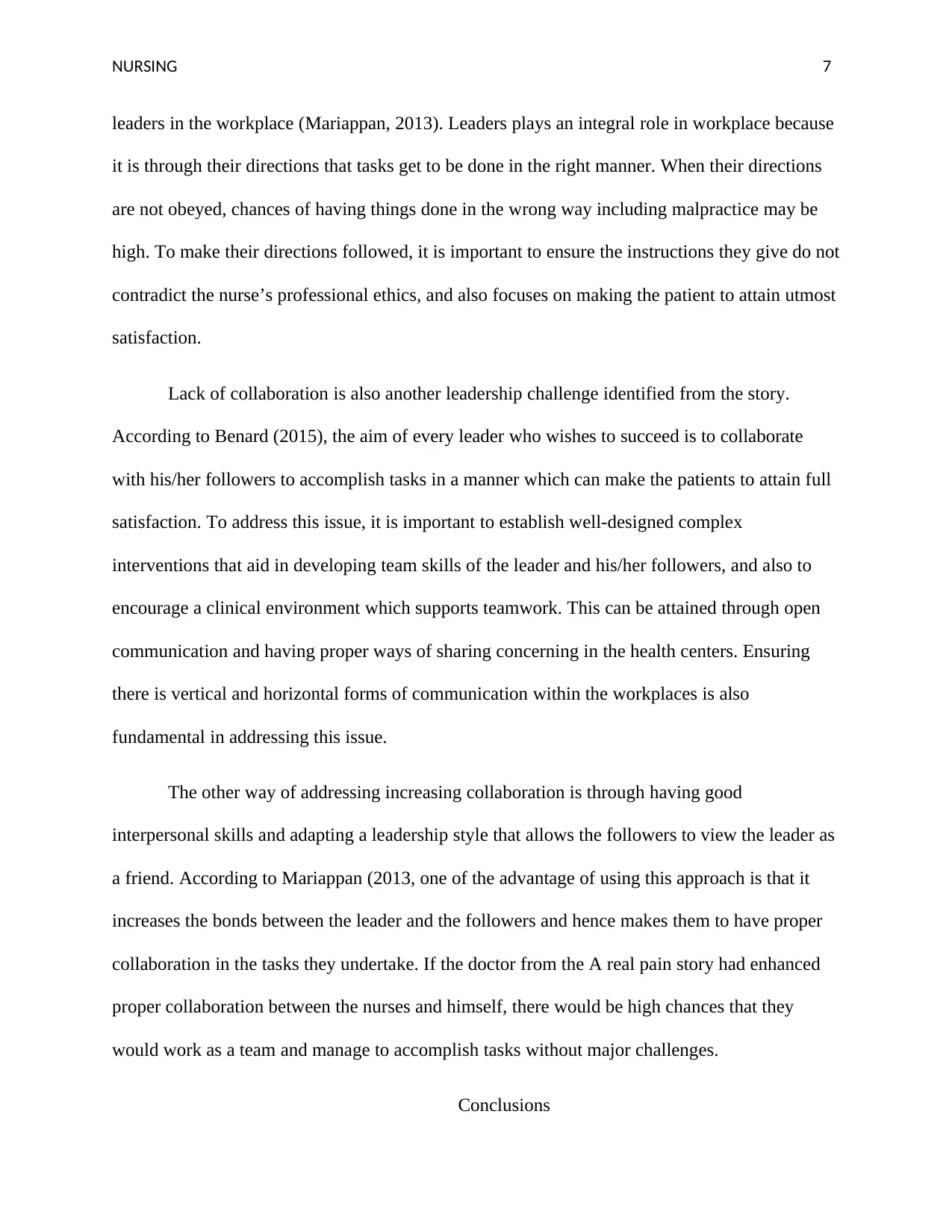
NURSING 7
leaders in the workplace (Mariappan, 2013). Leaders plays an integral role in workplace because
it is through their directions that tasks get to be done in the right manner. When their directions
are not obeyed, chances of having things done in the wrong way including malpractice may be
high. To make their directions followed, it is important to ensure the instructions they give do not
contradict the nurse’s professional ethics, and also focuses on making the patient to attain utmost
satisfaction.
Lack of collaboration is also another leadership challenge identified from the story.
According to Benard (2015), the aim of every leader who wishes to succeed is to collaborate
with his/her followers to accomplish tasks in a manner which can make the patients to attain full
satisfaction. To address this issue, it is important to establish well-designed complex
interventions that aid in developing team skills of the leader and his/her followers, and also to
encourage a clinical environment which supports teamwork. This can be attained through open
communication and having proper ways of sharing concerning in the health centers. Ensuring
there is vertical and horizontal forms of communication within the workplaces is also
fundamental in addressing this issue.
The other way of addressing increasing collaboration is through having good
interpersonal skills and adapting a leadership style that allows the followers to view the leader as
a friend. According to Mariappan (2013, one of the advantage of using this approach is that it
increases the bonds between the leader and the followers and hence makes them to have proper
collaboration in the tasks they undertake. If the doctor from the A real pain story had enhanced
proper collaboration between the nurses and himself, there would be high chances that they
would work as a team and manage to accomplish tasks without major challenges.
Conclusions
leaders in the workplace (Mariappan, 2013). Leaders plays an integral role in workplace because
it is through their directions that tasks get to be done in the right manner. When their directions
are not obeyed, chances of having things done in the wrong way including malpractice may be
high. To make their directions followed, it is important to ensure the instructions they give do not
contradict the nurse’s professional ethics, and also focuses on making the patient to attain utmost
satisfaction.
Lack of collaboration is also another leadership challenge identified from the story.
According to Benard (2015), the aim of every leader who wishes to succeed is to collaborate
with his/her followers to accomplish tasks in a manner which can make the patients to attain full
satisfaction. To address this issue, it is important to establish well-designed complex
interventions that aid in developing team skills of the leader and his/her followers, and also to
encourage a clinical environment which supports teamwork. This can be attained through open
communication and having proper ways of sharing concerning in the health centers. Ensuring
there is vertical and horizontal forms of communication within the workplaces is also
fundamental in addressing this issue.
The other way of addressing increasing collaboration is through having good
interpersonal skills and adapting a leadership style that allows the followers to view the leader as
a friend. According to Mariappan (2013, one of the advantage of using this approach is that it
increases the bonds between the leader and the followers and hence makes them to have proper
collaboration in the tasks they undertake. If the doctor from the A real pain story had enhanced
proper collaboration between the nurses and himself, there would be high chances that they
would work as a team and manage to accomplish tasks without major challenges.
Conclusions
Paraphrase This Document
Need a fresh take? Get an instant paraphrase of this document with our AI Paraphraser
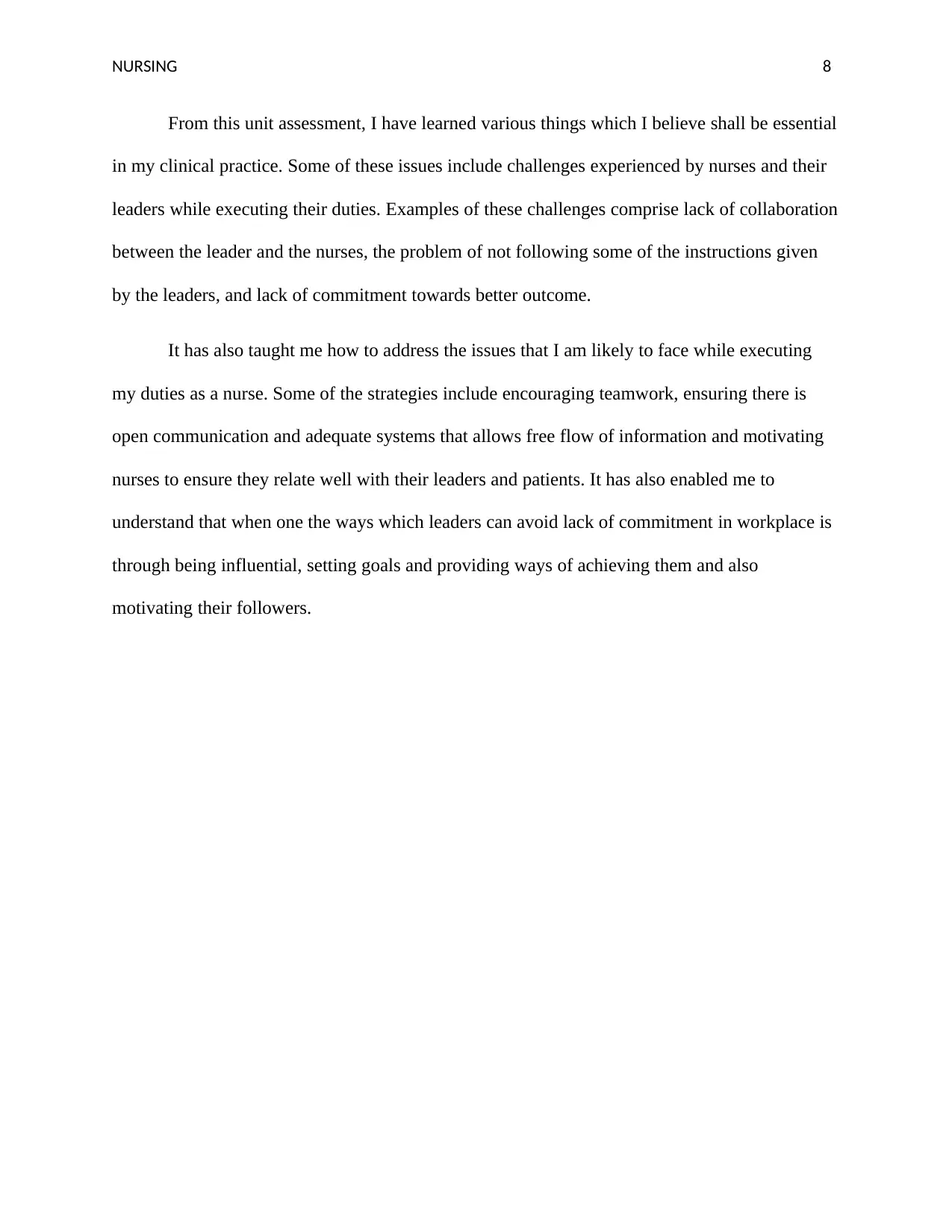
NURSING 8
From this unit assessment, I have learned various things which I believe shall be essential
in my clinical practice. Some of these issues include challenges experienced by nurses and their
leaders while executing their duties. Examples of these challenges comprise lack of collaboration
between the leader and the nurses, the problem of not following some of the instructions given
by the leaders, and lack of commitment towards better outcome.
It has also taught me how to address the issues that I am likely to face while executing
my duties as a nurse. Some of the strategies include encouraging teamwork, ensuring there is
open communication and adequate systems that allows free flow of information and motivating
nurses to ensure they relate well with their leaders and patients. It has also enabled me to
understand that when one the ways which leaders can avoid lack of commitment in workplace is
through being influential, setting goals and providing ways of achieving them and also
motivating their followers.
From this unit assessment, I have learned various things which I believe shall be essential
in my clinical practice. Some of these issues include challenges experienced by nurses and their
leaders while executing their duties. Examples of these challenges comprise lack of collaboration
between the leader and the nurses, the problem of not following some of the instructions given
by the leaders, and lack of commitment towards better outcome.
It has also taught me how to address the issues that I am likely to face while executing
my duties as a nurse. Some of the strategies include encouraging teamwork, ensuring there is
open communication and adequate systems that allows free flow of information and motivating
nurses to ensure they relate well with their leaders and patients. It has also enabled me to
understand that when one the ways which leaders can avoid lack of commitment in workplace is
through being influential, setting goals and providing ways of achieving them and also
motivating their followers.
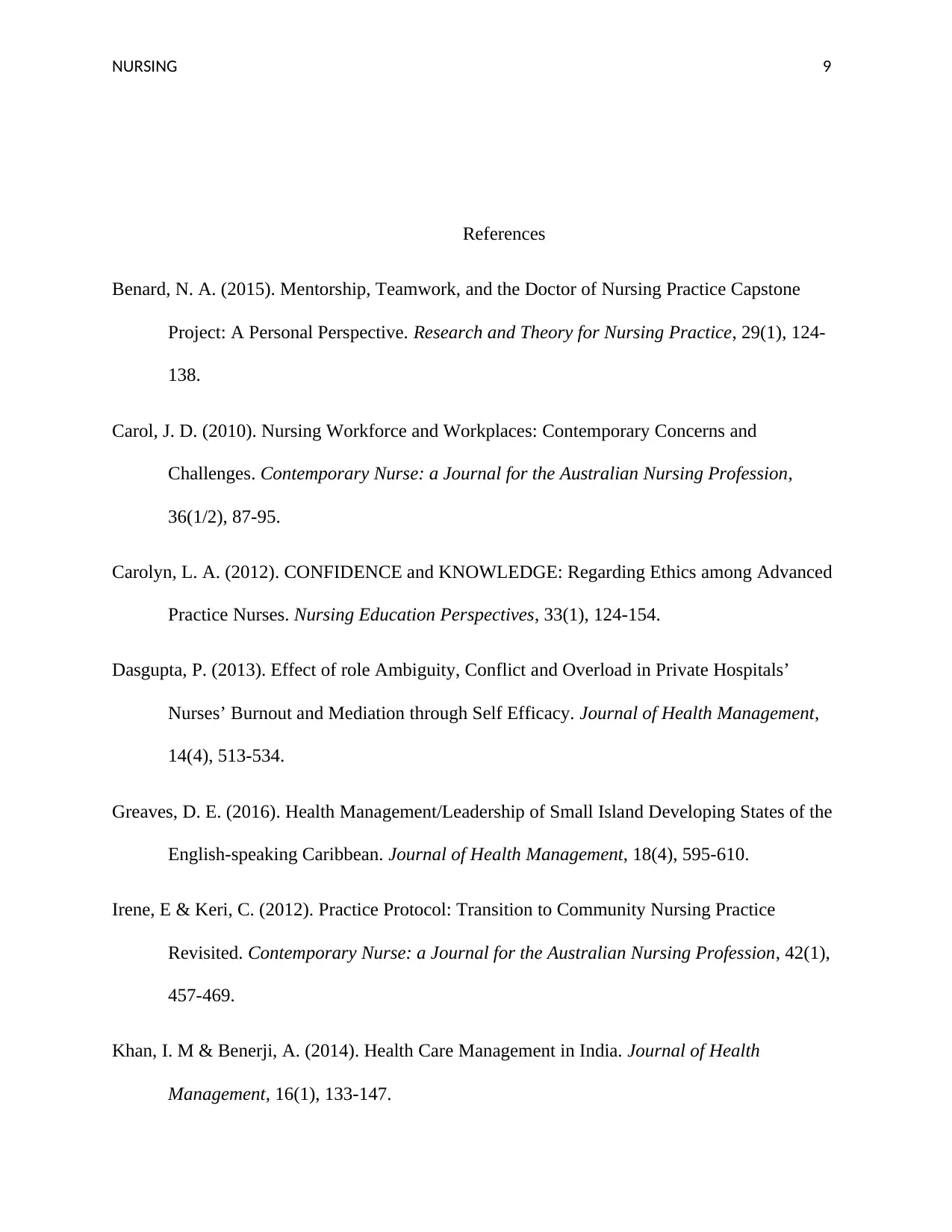
NURSING 9
References
Benard, N. A. (2015). Mentorship, Teamwork, and the Doctor of Nursing Practice Capstone
Project: A Personal Perspective. Research and Theory for Nursing Practice, 29(1), 124-
138.
Carol, J. D. (2010). Nursing Workforce and Workplaces: Contemporary Concerns and
Challenges. Contemporary Nurse: a Journal for the Australian Nursing Profession,
36(1/2), 87-95.
Carolyn, L. A. (2012). CONFIDENCE and KNOWLEDGE: Regarding Ethics among Advanced
Practice Nurses. Nursing Education Perspectives, 33(1), 124-154.
Dasgupta, P. (2013). Effect of role Ambiguity, Conflict and Overload in Private Hospitals’
Nurses’ Burnout and Mediation through Self Efficacy. Journal of Health Management,
14(4), 513-534.
Greaves, D. E. (2016). Health Management/Leadership of Small Island Developing States of the
English-speaking Caribbean. Journal of Health Management, 18(4), 595-610.
Irene, E & Keri, C. (2012). Practice Protocol: Transition to Community Nursing Practice
Revisited. Contemporary Nurse: a Journal for the Australian Nursing Profession, 42(1),
457-469.
Khan, I. M & Benerji, A. (2014). Health Care Management in India. Journal of Health
Management, 16(1), 133-147.
References
Benard, N. A. (2015). Mentorship, Teamwork, and the Doctor of Nursing Practice Capstone
Project: A Personal Perspective. Research and Theory for Nursing Practice, 29(1), 124-
138.
Carol, J. D. (2010). Nursing Workforce and Workplaces: Contemporary Concerns and
Challenges. Contemporary Nurse: a Journal for the Australian Nursing Profession,
36(1/2), 87-95.
Carolyn, L. A. (2012). CONFIDENCE and KNOWLEDGE: Regarding Ethics among Advanced
Practice Nurses. Nursing Education Perspectives, 33(1), 124-154.
Dasgupta, P. (2013). Effect of role Ambiguity, Conflict and Overload in Private Hospitals’
Nurses’ Burnout and Mediation through Self Efficacy. Journal of Health Management,
14(4), 513-534.
Greaves, D. E. (2016). Health Management/Leadership of Small Island Developing States of the
English-speaking Caribbean. Journal of Health Management, 18(4), 595-610.
Irene, E & Keri, C. (2012). Practice Protocol: Transition to Community Nursing Practice
Revisited. Contemporary Nurse: a Journal for the Australian Nursing Profession, 42(1),
457-469.
Khan, I. M & Benerji, A. (2014). Health Care Management in India. Journal of Health
Management, 16(1), 133-147.
⊘ This is a preview!⊘
Do you want full access?
Subscribe today to unlock all pages.

Trusted by 1+ million students worldwide
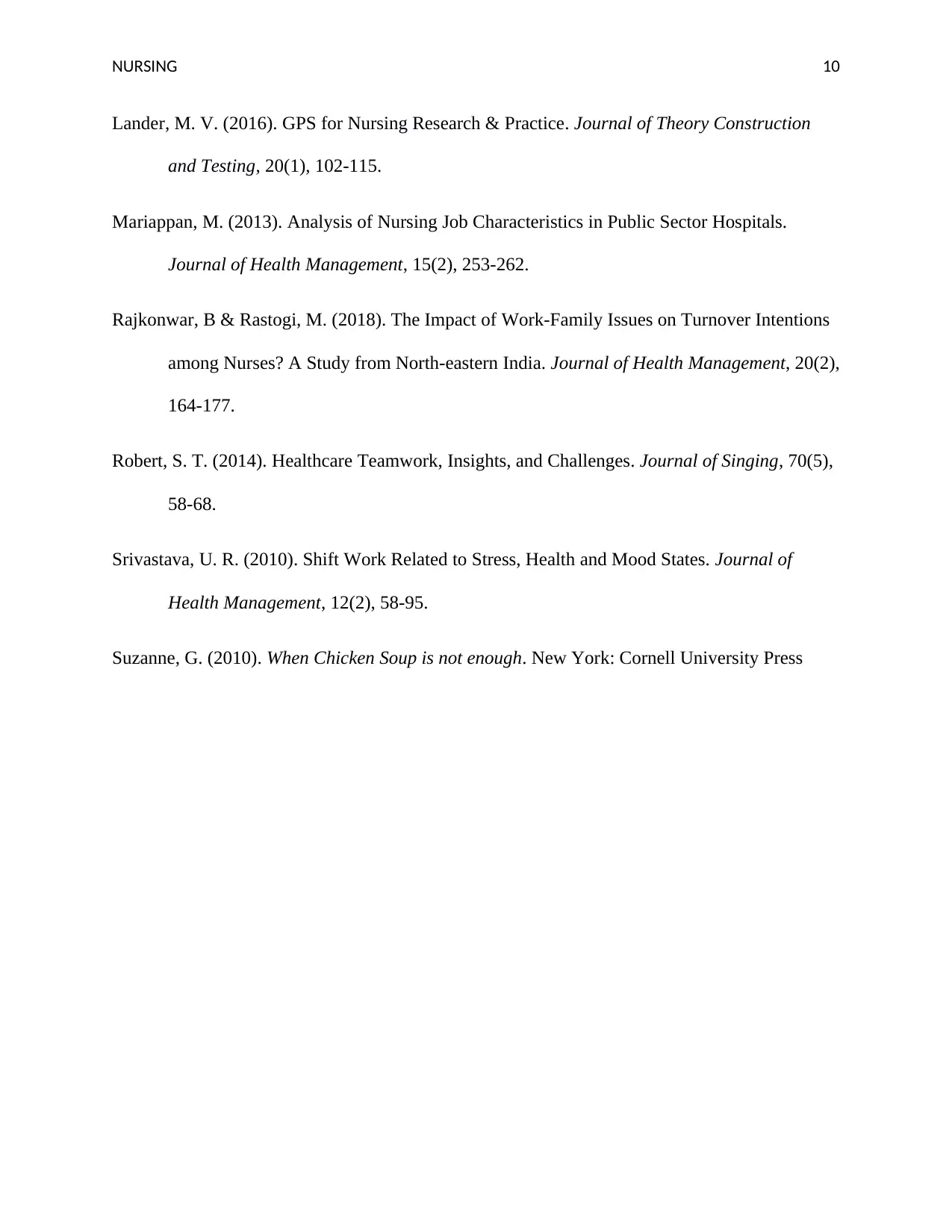
NURSING 10
Lander, M. V. (2016). GPS for Nursing Research & Practice. Journal of Theory Construction
and Testing, 20(1), 102-115.
Mariappan, M. (2013). Analysis of Nursing Job Characteristics in Public Sector Hospitals.
Journal of Health Management, 15(2), 253-262.
Rajkonwar, B & Rastogi, M. (2018). The Impact of Work-Family Issues on Turnover Intentions
among Nurses? A Study from North-eastern India. Journal of Health Management, 20(2),
164-177.
Robert, S. T. (2014). Healthcare Teamwork, Insights, and Challenges. Journal of Singing, 70(5),
58-68.
Srivastava, U. R. (2010). Shift Work Related to Stress, Health and Mood States. Journal of
Health Management, 12(2), 58-95.
Suzanne, G. (2010). When Chicken Soup is not enough. New York: Cornell University Press
Lander, M. V. (2016). GPS for Nursing Research & Practice. Journal of Theory Construction
and Testing, 20(1), 102-115.
Mariappan, M. (2013). Analysis of Nursing Job Characteristics in Public Sector Hospitals.
Journal of Health Management, 15(2), 253-262.
Rajkonwar, B & Rastogi, M. (2018). The Impact of Work-Family Issues on Turnover Intentions
among Nurses? A Study from North-eastern India. Journal of Health Management, 20(2),
164-177.
Robert, S. T. (2014). Healthcare Teamwork, Insights, and Challenges. Journal of Singing, 70(5),
58-68.
Srivastava, U. R. (2010). Shift Work Related to Stress, Health and Mood States. Journal of
Health Management, 12(2), 58-95.
Suzanne, G. (2010). When Chicken Soup is not enough. New York: Cornell University Press
1 out of 10
Related Documents
Your All-in-One AI-Powered Toolkit for Academic Success.
+13062052269
info@desklib.com
Available 24*7 on WhatsApp / Email
![[object Object]](/_next/static/media/star-bottom.7253800d.svg)
Unlock your academic potential
Copyright © 2020–2025 A2Z Services. All Rights Reserved. Developed and managed by ZUCOL.





